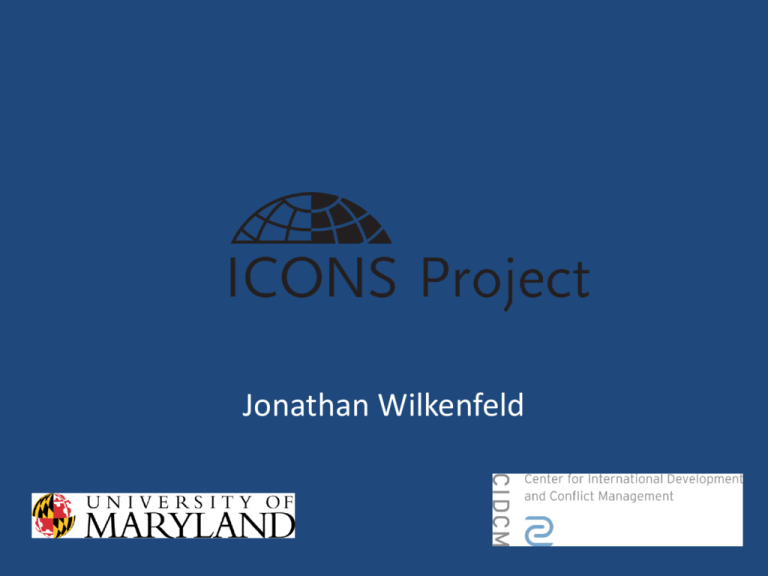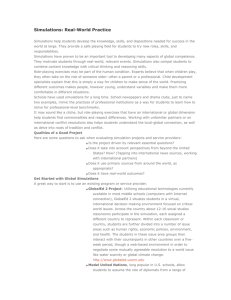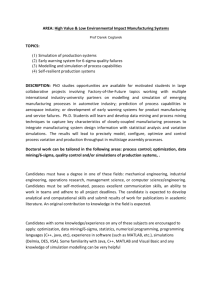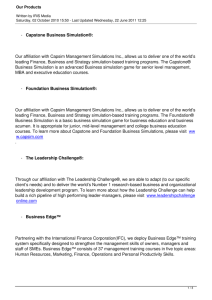Simulation for Crisis Management
advertisement

Jonathan Wilkenfeld ICONS PROJECT OVERVIEW • Training and education arm of the Center for International Development and Conflict Management • Over 25 years experience with the delivery of online simulation exercises in international politics and foreign policy decision making • ICONS offers multi-player, real-time distributed simulation exercises • Team of world-class trainers and simulation developers • Customizable and available world-wide ICONS Project TRAINING U.S. Government Agencies Think Tanks Private Corporations NGOs EDUCATION Universities High Schools Training • The ICONS Project advances learning by designing and delivering interactive leadership training on conflict management, negotiation and crisis leadership KEY LEADERSHIP COMPETENCIES: Conflict Management/Resolution Negotiation Collaboration and Problem Solving Crisis Leadership Selected Simulations • • • • • • Crisis in North Korea Globalization and Nigerian Oil Crisis in Kashmir Crisis in Valleyton Avian Influenza Crisis Crisis in East Asia Selected clients: • Department of Homeland Security (DHS) • National Aeronautics and Space Administration (NASA) • Environmental Protection Agency (EPA) • Central Intelligence Agency (CIA) • Federal Bureau of Investigation (FBI) • National Security Agency (NSA) • Food and Drug Administration (FDA) • U.S. Agency for International Development (USAID) • Belfer Center for Science and International Affairs- Harvard University • Carnegie Endowment for International Peace • Brookings Institution • Maryland Leadership Institute Benefits of ICONS Simulations • User-friendly software and support materials • Simulations can be tailored for any group of participants • Engaging • Interactive • Ability to monitor/facilitate each exercise • Complete transcript of activity for later debrief and analysis • Flexibility (location – anywhere in the world) Simulation for Crisis Management Jonathan Wilkenfeld Center for International Development and Conflict Management, and ICONS project University of Maryland War Games versus Simulations • Traditional war games are used by major powers to test plans and identify strategies • Broader geopolitical simulations involve a greater range of policy options and integrate domestic and international political factors Key Features of Crisis Simulations • Include both military and geopolitical considerations • Participants must consider objective situation as well as domestic and international politics • Provide opportunity for broader and deeper knowledge of global situation and other actors’ perspectives • Permit participants to develop individual and organizational skills Options for Conducting Simulations • Participants can play the role of their own country’s decision makers to evaluate their decision processes and options • They can play the role of a neutral party to develop objective insights on the dynamics of international politics • They can play the role of the other country’s decision makers to improve their understanding of that country’ politics and processes Simulation as a Training Environment • Multi-level nature of simulations provides for understanding dynamics of international politics and development of new means of communication and collaboration within teams • Learning takes place within participants teams and also within control team, which had a broader perspective and gains understanding of the interplay of political, military and economic forces • Can explore contingencies and sensitive topics in an atmosphere of confidentiality • Evaluate plans in light of scientific experience Learning Outcomes from Simulations • Increased knowledge of international issues through scenario research and writing • Deeper understanding of own country’s goals, norms, practices and capabilities • Improved insight into political dynamics and culture of other countries • Ability to evaluate impact of potential policies on other countries’ actions and on broader international environment The Use of Simulations in Policy Formation and Analysis Jonathan Wilkenfeld Center for International Development and Conflict Management, and ICONS project University of Maryland “Simulations are ‘interactive events’ in which ‘it is the environment that is simulated’…but the behavior is real.” -Jones (1955) Simulation Stages • Preparation: participants evaluate the initial situation and the role that they are portraying • Interaction: participants have a chance to put their initial positions into action as they attempt to achieve their goals • Debriefing: includes guided group discussions, and gives participants the chance to identify general principles Simulation Design Considerations • What are the policy formulation and evaluation goals • What kind of time and technological limitations will be faced • Will the simulation be base on a real or fictional case • What is the desired level of complexity • How many participants and how will they be organized • What will the decision-making processes be (intra-team and between teams) • How active will the control team be in introducing new situations and in prodding the teams • Will outcomes be structures or open-ended • Will there be any constraints on participants, if so what kinds How Goals Affect Structure • Are you attempting to train participants in the use of a procedure or technique, Or • Are you attempting to teach them particular concepts of content or process, Or • Are you attempting to evaluate a plan or procedure? If you are teaching concepts: • Decide whether learning about process (e.g., decision making, negotiation) or content (the facts, history that provides the context for this simulation) is more important – Most simulations provide opportunities for learning on both fronts, but you must decide which is primary • Determine the appropriate balance between the preparation and interaction stages – Process-oriented simulations teach by doing; focus more on the interaction among participants – Content-oriented simulations should delve deeply into the subject matter in preparation for the simulation How Limitations affect Structure • What you are able to accomplish with your simulation will be limited by the time and technology available • These constraints may dictate certain choices that might otherwise have been decided by your goals Time and Technology • Time: choose how to balance the time available between participant preparation and interaction • Technology: the availability of computers and internet access provides some opportunities for enhancing the simulation experience, but the use of technology requires careful consideration Not all simulations are best conducted using computers The ICONS Simulations When to use ICONSnet Running a simulation within ICONSnet is useful if any of the following considerations is important to your simulation design or instructional goals: • Anonymity • Conducting simulations as asynchronously • Conducting simulations over a distance (distributed simulations) • Supporting two-level dynamics (i.e., interactions within teams, as well as between teams) • Maintaining full archives of the simulation proceedings • Managing votes on proposals • Keeping a detailed record of actions taken Elements of Scenario Design • • • • • Model of reality Simplicity versus detail Motivating – adapt to level of participants Scripted versus the unexpected Sources of input Elements of Design, Cont’d • • • • • Extent of intervention Control team functions Archiving for summary analysis Public versus restricted access Participants Opening Scenario • • • • • • • Early 2013 Economic recovery proceeding slowly Russia drifting toward totalitarianism Sporadic violence continues in Middle East United States bogged down in Afghanistan Little action on global issues Friction among major powers increasing • • • • China resists criticism on human rights North Korean nuclear program continuing US -China trade relations deteriorating US electorate divided over foreign policy, and limited attention to East Asia leads some observers to conclude that US less willing to be “external balancer” in the region • New leadership in China with little military experience • Limited progress in cross-Strait dialogue • PLA capabilities continue to grow, including missile force; criticized by Taiwan leadership • Ma won re-election in Taiwan by slim margin • Ma and new Chinese leadership risk a new dialogue on peace accord, but Ma insists on reduction in missiles • This demand, and internal politics, lead to a split in China on how to react • PLA, on own authority, initiates campaign to provoke Taiwan • Actions include hacking computer systems, close approaches by aircraft and naval forces • Taiwan responds with aggressive military patrols and computer attacks • New Chinese leadership caught unawares • Accidental clashes occur, escalating conflict North Korea Nuclear Scenario Background • The year is 2001 and continuing efforts by China, the US, Japan, Russia, and South Korea to forestall North Korea’s nuclear weapons program have made little progress • Strong consensus within the 5 parties – based on shared intelligence – that North Korea possesses several nuclear weapons • The DPRK has also tested medium-range missiles, sufficient range to reach all major Japanese populations centers Background, cont’d • The US has made thinly veiled threats to attack North Korean military and nuclear facilities • In 2010 the US went so far as to alert its Pacific Command forces in an effort to pressure the DPRK to abandon its nuclear program • China alerted its own forces, citing the provision in the PRC-DPRK Treaty of Friendship, Co-operation and Mutual Assistance calling for military assistance in the event that either party is threatened. • The US Department of Defense and the Japanese Defense Agency have agreed to construct a comprehensive missile defense shield for Japan State of US-China Relations • Deteriorated as a result of growing tensions over Taiwan, human rights issues, China’s ongoing military modernization, and policies toward the Asian region • Conservatives in both countries press for more “hardline” policies toward each other • US and China have moved closer to a confrontation over their mutually diverging interests and their perceived need to support key regional allies Initial Conditions • US intelligence reports North Korea raised alert level of its military forces, apparently in reaction to US-Japan dialogue on missile defense • North Korean sub detected in Japanese waters • Both US and China fear that situation in region could further deteriorate, leading to use of force by North Korea, extending even to its nuclear arsenal • US and China also concerned about ROK’s reaction and in particular that the South Korean military may attempt some kind of preemptive action • Japan, traditionally restrained and committed to regional stability, is feeling increasing pressure to respond forcefully Triggering Events • US decides to increase alert level of its forces in South Korea and to accelerate deployment of additional Aegis ships to the Sea of Japan • China has decided to dispatch two destroyers of the East Sea Fleet to the region to monitor and report on the US fleet, and to underscore China’s determination to resist US attempts to pressure North Korea • US and China convene high level crisis management teams







